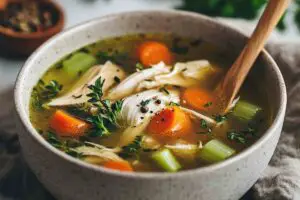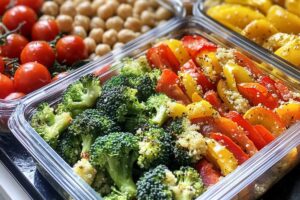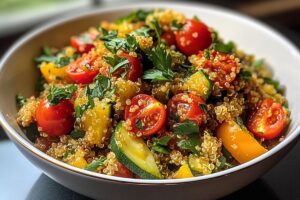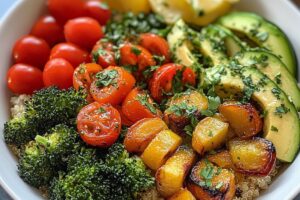Vegetable Soup
Vegetable soup is a delightful dish that warms the heart and nourishes the body. It’s a simple yet versatile meal that can be enjoyed any time of the year. Whether you’re looking for a light lunch or a comforting dinner, vegetable soup fits the bill perfectly. This dish is not only easy to prepare but also allows for endless variations, making it a favorite among many.
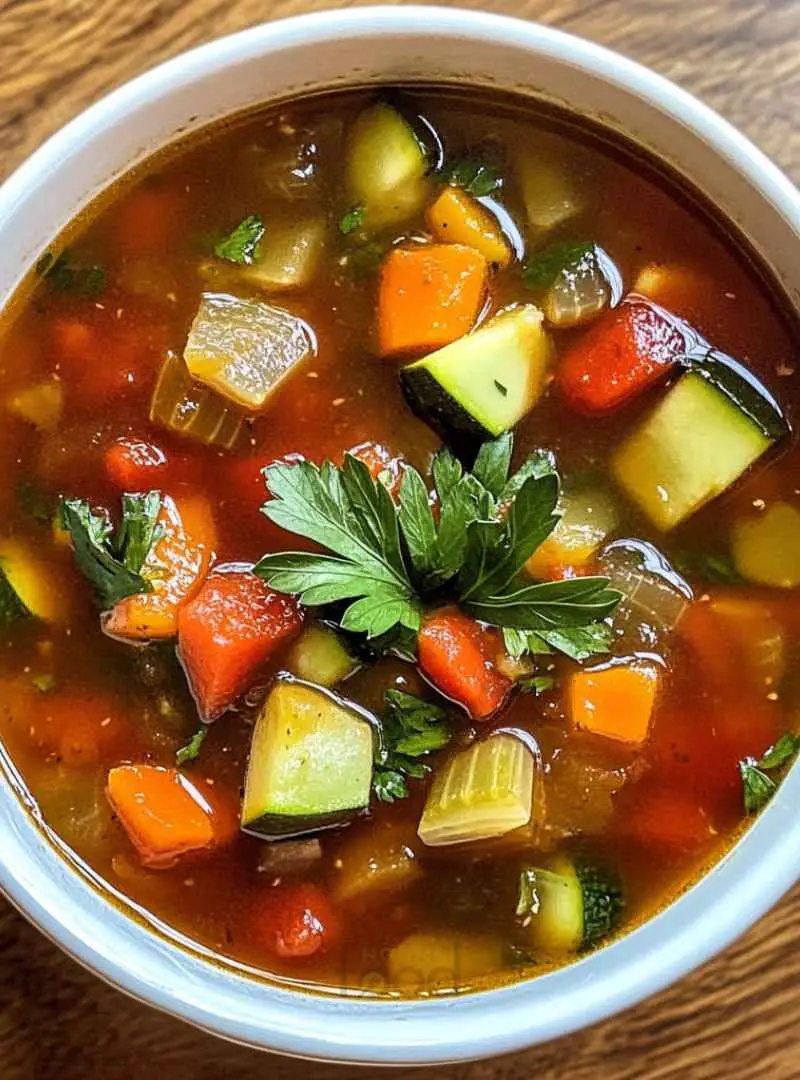
What is Vegetable Soup?
Vegetable soup is a savory broth filled with a variety of vegetables. It can be made with fresh, frozen, or canned ingredients, making it accessible for everyone. The base is usually a vegetable broth, which adds depth and flavor. You can customize it with your favorite vegetables, herbs, and spices. This flexibility means you can create a unique soup every time you make it!
Benefits of Eating Vegetable Soup
Eating vegetable soup comes with numerous health benefits. First, it’s packed with vitamins and minerals from the vegetables. These nutrients support your immune system and overall health. Additionally, vegetable soup is low in calories, making it a great option for those watching their weight. The high water content helps keep you hydrated, too.
Moreover, vegetable soup is an excellent way to increase your vegetable intake. Many people struggle to eat enough veggies daily, but a warm bowl of soup can make it easier. Plus, it’s a comforting dish that can lift your spirits, especially on chilly days. So, whether you’re on a health journey or just looking for a tasty meal, vegetable soup is a fantastic choice!
Ingredients for Vegetable Soup
Fresh Ingredients for a Wholesome Meal
To create a delicious vegetable soup, fresh ingredients are key. Using fresh vegetables not only enhances the flavor but also boosts the nutritional value of your soup. Here’s a list of fresh ingredients you’ll need:
- 1 onion, chopped
- 2 garlic cloves, minced
- 2 carrots, diced
- 2 celery stalks, diced
- 1 bell pepper, chopped
- 1 zucchini, diced
- 1 cup green beans, trimmed and cut into pieces
- Fresh parsley, chopped (for garnish)
These vegetables provide a colorful mix that makes your soup visually appealing. Each ingredient contributes unique flavors and textures, making every spoonful a delight. For instance, carrots add sweetness, while green beans offer a satisfying crunch. The combination of these fresh ingredients ensures that your vegetable soup is both wholesome and tasty.
Pantry Staples Needed for Vegetable Soup
In addition to fresh ingredients, you’ll need some pantry staples to complete your vegetable soup. These items are usually easy to find and can be stored for a long time. Here’s what you’ll need:
- 1 tablespoon olive oil
- 1 can (14.5 oz) diced tomatoes (no added sugar)
- 4 cups vegetable broth
- 1 teaspoon dried thyme
- 1 teaspoon dried basil
- Salt and pepper to taste
Olive oil is perfect for sautéing the vegetables, adding a rich flavor. Diced tomatoes bring acidity and sweetness, while vegetable broth serves as the soup’s base. Dried herbs like thyme and basil enhance the overall taste, making your soup aromatic and inviting. With these pantry staples, you can whip up a delightful vegetable soup anytime!
Preparation of Vegetable Soup
Step 1: Sauté the Vegetables
To start your vegetable soup, heat 1 tablespoon of olive oil in a large pot over medium heat. Once the oil is hot, add the chopped onion. Sauté the onion for about 3-4 minutes until it becomes translucent. This step is crucial as it builds the base flavor of your soup. Next, stir in the minced garlic and cook for an additional minute. You’ll know it’s ready when the garlic becomes fragrant, filling your kitchen with a delightful aroma.
Step 2: Add Remaining Vegetables
Now it’s time to add the rest of the vegetables! Toss in the diced carrots, celery, bell pepper, zucchini, and green beans. Stir everything together and let it cook for about 5-7 minutes. Keep stirring occasionally to ensure even cooking. You want the vegetables to begin softening but not fully cooked yet. This step allows the flavors to meld together, creating a delicious foundation for your soup.
Step 3: Incorporate Broth and Seasonings
Once the vegetables have softened, it’s time to add the liquid. Pour in the can of diced tomatoes along with their juices, followed by 4 cups of vegetable broth. Stir in 1 teaspoon of dried thyme and 1 teaspoon of dried basil. These herbs will add a wonderful aroma and flavor to your soup. Don’t forget to season with salt and pepper to taste. Bring the mixture to a boil, which will help combine all the flavors beautifully.
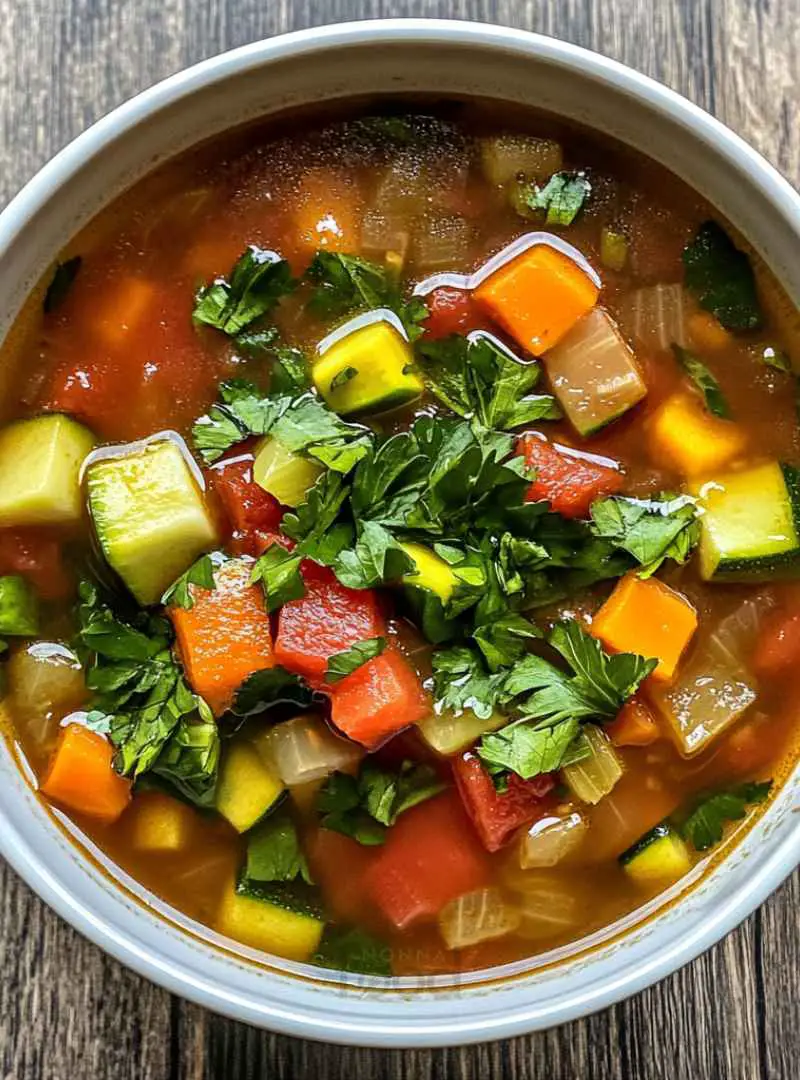
Variations of Vegetable Soup
Adding Protein to Your Vegetable Soup
While vegetable soup is delicious on its own, adding protein can make it even more satisfying. Protein helps keep you full and provides essential nutrients. There are several great options to consider. For instance, you can add beans like chickpeas or black beans. They not only boost the protein content but also add a creamy texture.
Another option is to include lentils. They cook quickly and blend well with the soup. If you prefer animal protein, shredded chicken or turkey can be a tasty addition. Just make sure to add it during the simmering stage so it warms through. Tofu is also a fantastic choice for a plant-based protein. It absorbs the flavors of the soup, making every bite delightful!
Exploring Different Vegetable Combinations
One of the best things about vegetable soup is its versatility. You can mix and match vegetables based on what you have on hand or what’s in season. For example, try adding sweet potatoes for a hint of sweetness and a creamy texture. Spinach or kale can be tossed in during the last few minutes of cooking for added nutrition.
Don’t forget about seasonal vegetables! In the summer, zucchini and corn are perfect, while root vegetables like parsnips and turnips shine in the fall. You can even experiment with different herbs and spices to create unique flavors. The possibilities are endless, making vegetable soup a fun dish to customize!
Cooking Note for Vegetable Soup
Tips for Perfecting Your Vegetable Soup
Making a delicious vegetable soup is an art, and a few tips can help you master it. First, always use fresh ingredients. Fresh vegetables not only taste better but also provide more nutrients. When selecting your veggies, look for vibrant colors and firm textures. This ensures you’re getting the best quality for your soup.
Next, don’t rush the sautéing process. Taking the time to properly sauté the onions and garlic builds a rich flavor base. This step is crucial for a tasty soup. Also, consider adding a splash of lemon juice or vinegar at the end. This brightens the flavors and adds a delightful zing!
Another tip is to let your soup simmer longer. The longer it simmers, the more the flavors meld together. If you have time, let it cook for an hour or more. Just keep an eye on the vegetables to ensure they don’t become mushy. If you prefer a thicker soup, you can blend a portion of it and stir it back in. This creates a creamy texture without adding dairy.
Lastly, always taste your soup before serving. Adjust the seasoning as needed. A little extra salt or a pinch of pepper can make a big difference. Remember, cooking is about experimenting and finding what you love. So, don’t be afraid to make it your own!
Serving Suggestions for Vegetable Soup
Pairing Vegetable Soup with Other Dishes
Vegetable soup is a versatile dish that pairs wonderfully with various foods. One classic pairing is a slice of crusty bread. A warm, fresh loaf complements the soup perfectly, allowing you to soak up every last drop. You can also serve it with a side salad for a light and refreshing meal. A simple green salad with a tangy vinaigrette can balance the warmth of the soup.
If you’re looking for something heartier, consider serving your vegetable soup with a grilled cheese sandwich. The gooey cheese and crispy bread create a delightful contrast to the warm soup. For a more filling option, try pairing it with a quinoa or rice bowl. This combination adds extra fiber and protein, making your meal more satisfying.
For those who enjoy a bit of spice, serve your vegetable soup with a side of spicy roasted chickpeas. They add a crunchy texture and a kick of flavor. You can also offer a dollop of pesto or a sprinkle of cheese on top of the soup for added richness. These pairings enhance the overall experience, making your meal even more enjoyable!
Creative Ways to Serve Vegetable Soup
Serving vegetable soup doesn’t have to be boring! Get creative with your presentation to make it more appealing. One fun idea is to serve the soup in bread bowls. Hollow out a small loaf of bread and fill it with hot soup. This not only looks impressive but also adds a delicious bread element to your meal.
Another creative option is to use mason jars for individual servings. This is perfect for gatherings or meal prep. You can layer the ingredients in the jar for a beautiful display. When ready to eat, simply heat the jar in the microwave or pour it into a bowl.
For a touch of elegance, consider garnishing your soup with fresh herbs or a swirl of olive oil. This adds color and a burst of flavor. You can also serve it with a variety of toppings, such as croutons, avocado slices, or even a sprinkle of nutritional yeast for a cheesy flavor without dairy.
Lastly, don’t forget about the season! In the fall, you can serve your vegetable soup in mini pumpkins for a festive touch. In the summer, a chilled version of the soup can be served in a glass with a straw for a refreshing twist. These creative serving ideas will impress your guests and make your vegetable soup experience even more delightful!
Tips for Making the Best Vegetable Soup
Choosing the Right Vegetables
When it comes to making the best vegetable soup, selecting the right vegetables is essential. Freshness is key! Always choose vibrant, firm vegetables. They not only taste better but also provide more nutrients. Seasonal vegetables are a great choice, as they are often at their peak flavor. For example, in the spring, you might enjoy asparagus and peas, while fall brings hearty root vegetables like carrots and potatoes.
Mixing different colors of vegetables can make your soup visually appealing. Think about adding leafy greens like spinach or kale for a pop of color and added nutrition. You can also experiment with textures. Crunchy vegetables like bell peppers and green beans contrast nicely with softer ones like zucchini and tomatoes. This variety keeps each spoonful interesting and satisfying!
Don’t forget about frozen vegetables! They can be a convenient option when fresh ones aren’t available. Frozen veggies are often picked at their peak ripeness and flash-frozen, preserving their nutrients. Just be sure to thaw them before adding them to your soup for even cooking.
Enhancing Flavor in Your Vegetable Soup
To elevate the flavor of your vegetable soup, consider a few simple techniques. First, start with a good base. Using homemade vegetable broth can make a significant difference. If you don’t have time to make your own, choose a high-quality store-bought option. Look for low-sodium varieties to control the saltiness of your soup.
Next, don’t shy away from herbs and spices! Fresh herbs like basil, thyme, and parsley can brighten your soup. Dried herbs are also effective; just remember to add them early in the cooking process to allow their flavors to develop. For a little kick, consider adding a pinch of red pepper flakes or a dash of hot sauce.
Another way to enhance flavor is by adding acidity. A splash of lemon juice or a teaspoon of vinegar at the end of cooking can brighten the overall taste. This small addition can transform your soup from good to great! Lastly, always taste your soup before serving. Adjust the seasoning as needed, and don’t hesitate to add a little more salt or pepper to bring out the flavors.
Breakdown of Time for Vegetable Soup
Prep Time
Preparing your vegetable soup is quick and easy! The prep time for this delicious dish is about 15 minutes. During this time, you’ll chop the vegetables, mince the garlic, and gather all your ingredients. Having everything ready before you start cooking makes the process smoother and more enjoyable. Plus, it allows you to focus on creating a flavorful soup without any distractions!
Cooking Time
The cooking time for vegetable soup is approximately 30 minutes. This includes sautéing the vegetables, simmering the soup, and allowing the flavors to meld together. Sautéing the onions and garlic takes about 4-5 minutes, while the remaining vegetables need about 5-7 minutes to soften. After adding the broth and seasonings, let the soup simmer for 20-25 minutes. This step is crucial for achieving a rich and hearty flavor.
Total Time
In total, you’ll spend about 45 minutes making your vegetable soup. This includes both prep and cooking time. It’s a relatively quick meal that can easily fit into your busy schedule. Whether you’re making it for lunch or dinner, this wholesome soup is worth every minute spent in the kitchen. Plus, the delightful aroma that fills your home while it cooks is an added bonus!
Nutritional Information for Vegetable Soup
Calories and Macronutrients
Understanding the nutritional content of your vegetable soup is essential for maintaining a balanced diet. A typical serving of vegetable soup, which is about 1.5 cups, contains approximately 150 calories. This makes it a low-calorie option, perfect for those looking to manage their weight.
In terms of macronutrients, vegetable soup is primarily composed of carbohydrates, with about 30 grams per serving. These carbs mainly come from the vegetables, providing essential energy. Additionally, you can expect around 5 grams of protein, especially if you add beans or lentils. The fat content is minimal, usually around 3-5 grams, primarily from the olive oil used in cooking.
Moreover, this soup is rich in dietary fiber, with about 6 grams per serving. Fiber is crucial for digestive health and helps keep you feeling full longer. Overall, vegetable soup is a nutritious choice that supports a healthy lifestyle while being delicious and satisfying!
Health Benefits of the Ingredients
The ingredients in vegetable soup offer a wide range of health benefits. First, the variety of vegetables provides a rich source of vitamins and minerals. For example, carrots are high in vitamin A, which is essential for good vision and immune function. Onions and garlic contain antioxidants that help fight inflammation and boost heart health.
Additionally, leafy greens like spinach or kale, if added, are packed with iron and calcium, supporting bone health and energy levels. The use of vegetable broth as a base adds flavor without extra calories, making it a smart choice for hydration.
Furthermore, the fiber content from the vegetables aids digestion and helps regulate blood sugar levels. This is particularly beneficial for those managing diabetes or looking to maintain steady energy throughout the day. Overall, the combination of these ingredients makes vegetable soup not just a comforting meal but also a powerhouse of nutrition!
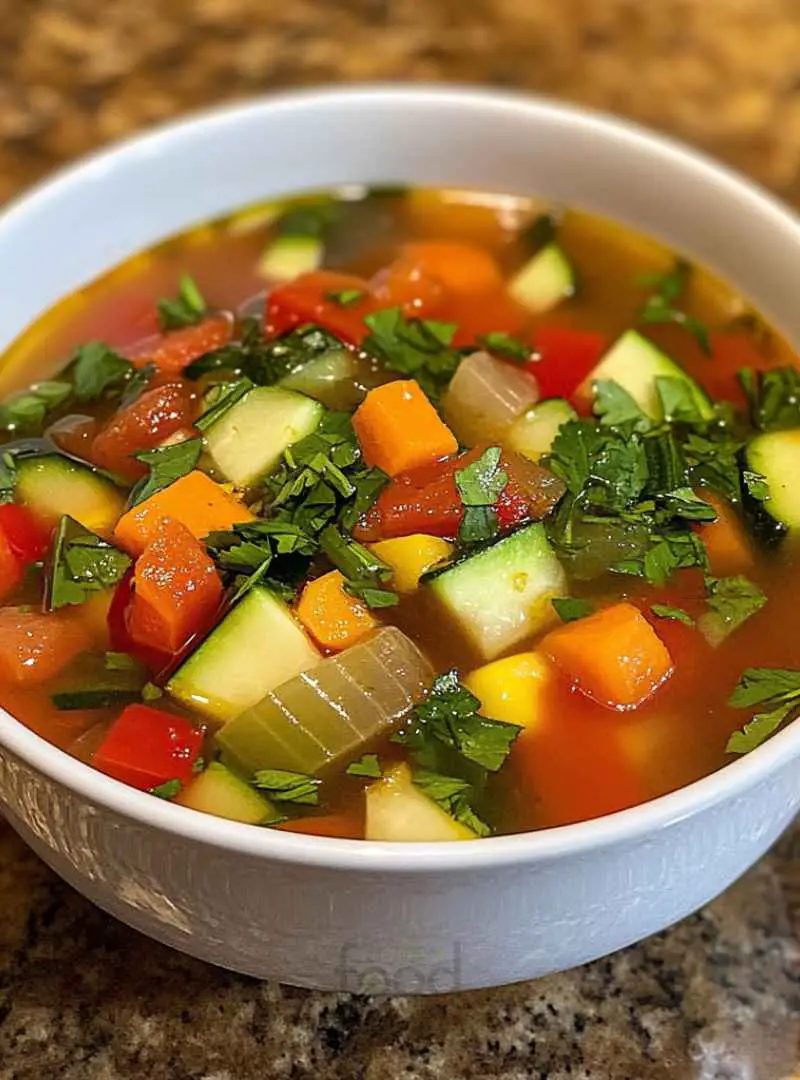
FAQs about Vegetable Soup
Can I freeze Vegetable Soup?
Yes, you can freeze vegetable soup! Freezing is a great way to preserve leftovers for later enjoyment. To freeze, let the soup cool completely. Then, transfer it to airtight containers or freezer bags. Be sure to leave some space at the top, as the soup will expand when frozen. Label the containers with the date, and you can store them for up to three months. When you’re ready to enjoy it again, simply thaw it in the refrigerator overnight and reheat on the stove or in the microwave.
How long does Vegetable Soup last in the fridge?
Vegetable soup can last in the fridge for about 3 to 5 days. To ensure it stays fresh, store it in an airtight container. Always check for any signs of spoilage, such as off smells or changes in texture, before consuming. If you notice any of these signs, it’s best to discard the soup. To enjoy it at its best, try to eat it within the first few days after cooking.
What can I add to Vegetable Soup for extra flavor?
There are many ways to enhance the flavor of your vegetable soup! You can add fresh herbs like basil, cilantro, or dill for a burst of freshness. A splash of lemon juice or vinegar can brighten the flavors, while a pinch of red pepper flakes adds a nice kick. For a richer taste, consider adding a tablespoon of soy sauce or miso paste. You can also stir in some nutritional yeast for a cheesy flavor without dairy. Experimenting with different spices and ingredients can make your soup even more delicious!
Is Vegetable Soup suitable for a Daniel Fast?
Absolutely! Vegetable soup is an excellent choice for those observing a Daniel Fast. This fast encourages the consumption of whole, plant-based foods, and vegetable soup fits perfectly within those guidelines. Just ensure that all ingredients are compliant, such as using vegetable broth without additives and avoiding any added sugars or preservatives. This nourishing soup can help you stay satisfied and energized during your fasting journey!
Conclusion on Vegetable Soup
Recap of the Benefits and Enjoyment of Vegetable Soup
In conclusion, vegetable soup is more than just a comforting dish; it’s a nutritious powerhouse that offers numerous health benefits. Packed with vitamins, minerals, and fiber, it supports your immune system and aids digestion. The versatility of vegetable soup allows you to customize it with your favorite ingredients, making it a delightful meal for any occasion.
Whether you’re enjoying a warm bowl on a chilly day or serving it at a gathering, vegetable soup brings people together. Its rich flavors and vibrant colors make it visually appealing and satisfying. Plus, it’s an excellent way to increase your vegetable intake, especially for those who may struggle to eat enough greens.
Moreover, the ease of preparation and the ability to make it in large batches make vegetable soup a practical choice for busy lifestyles. You can freeze leftovers for quick meals later, ensuring you always have a healthy option on hand. So, whether you’re on a health journey, observing a fast, or simply craving a delicious meal, vegetable soup is a fantastic choice that you can enjoy time and time again!
So, gather your fresh ingredients, follow the simple steps, and savor the warmth and nourishment of a homemade vegetable soup. Your body and taste buds will thank you!

Vegetable Soup
Ingredients
Equipment
Method
- Add diced carrots, celery, bell pepper, zucchini, and green beans. Stir and cook for 5-7 minutes until vegetables begin to soften.
- Pour in diced tomatoes with juices and vegetable broth. Stir in dried thyme and basil, and season with salt and pepper. Bring to a boil, then reduce heat and let simmer for 20-25 minutes.
- Taste and adjust seasoning if necessary. Serve hot, garnished with fresh parsley.

